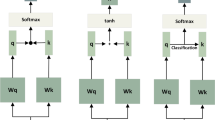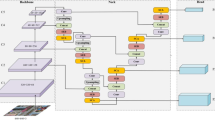Abstract
Driving style detection is an essential real-world requirement in diverse contexts, such as traffic safety, car insurance and fuel consumption optimization. However, the existing methods either rely on handcrafted features or fail to explore deep spatial-temporal features from multi-modal sensing signals. In this paper, we propose a novel attention-based hybrid convolutional neural network (CNN) and long short-term memory (LSTM) framework named DSDCLA to address these problems. Specifically, DSDCLA first introduces CNN and self-attention for extracting local spatial features from multi-modal driving sequences. Then, we utilize LSTM and multi-head attention to explore the long-term temporal relationships between timesteps. Therefore, DSDCLA can identify driving style by short- and long-term spatial-temporal features. Furthermore, we design three variants with different levels of fusion, which shows the advantage of selecting components and improves the interpretability. We extensively evaluated the proposed DSDCLA on two public real-world datasets, and the experimental results show that DSDCLA outperforms the current state-of-the-art methods, achieving the F1-scores of 97.03% and 97.65%. Numerous ablation studies and visualizations indicate the effectiveness of the model and the importance of multi-level attention fusion for identifying driving style between timesteps.









Similar content being viewed by others
Notes
This dataset is available at https://github.com/fdjingliu/FD-Driveset.
For better visualization, we process the raw data at high frequencies by low-pass filtering [32] to make the curves look smoother rather than violently jittery.
References
Azadani M N, Boukerche A (2021) Driving behavior analysis guidelines for intelligent transportation systems. IEEE Trans Intell Transp Syst:1–19, https://doi.org/10/gmwv7k
Bejani M M, Ghatee M (2018) A context aware system for driving style evaluation by an ensemble learning on smartphone sensors data. Transportation Research Part C: Emerging Technologies 89:303–320. https://doi.org/10/gdcv2s
Bejani M M, Ghatee M (2020) Convolutional neural network with adaptive regularization to classify driving styles on smartphones. IEEE Trans Intell Transp Syst 21(2):543–552. https://doi.org/10/gnkknp
Chan T K, Chin C S, Chen H et al (2020) A comprehensive review of driver behavior analysis utilizing smartphones. IEEE Trans Intell Transp Syst 21(10):4444–4475. https://doi.org/10/ghnt9h
Chechetka A (2019) Pilotguru. https://github.com/waiwnf/pilotguru
Chen J, Wu Z, Zhang J (2019) Driving safety risk prediction using cost-sensitive with nonnegativity-constrained autoencoders based on imbalanced naturalistic driving data. IEEE Trans Intell Transp Syst 20 (12):4450–4465. https://doi.org/10/gmwv65
Dhal P, Azad C (2022) A comprehensive survey on feature selection in the various fields of machine learning. Appl Intell 52(4):4543–4581. https://doi.org/10/gqqvrd
Dong W, Yuan T, Yang K et al (2017) Autoencoder regularized network for driving style representation learning. In: Proceedings of the twenty-sixth international joint conference on artificial intelligence, pp 1603–1609, https://doi.org/10/gqfpkp
Jain N, Mittal S (2021) Bayesian nash equilibrium based gaming model for eco-safe driving. J King Saud University - Comput Inf Sci, https://doi.org/10/gpktn8
Kenkar Z, AlHalawani S et al (2019) Event-based driving style analysis. In: Alfaries A, Mengash H, Yasar A (eds) Advances in data science, cyber security and IT applications. Springer international publishing, Cham, Communications in computer and information science, pp 170-182. https://doi.org/10/gm57kn
Khodairy M A, Abosamra G (2021) Driving behavior classification based on oversampled signals of smartphone embedded sensors using an optimized stacked-lstm neural networks. IEEE Access 9:4957–4972. https://doi.org/10/gmv3r7
Kieu T, Yang B, Jensen CS (2018) Outlier detection for multidimensional time series using deep neural networks. In: 2018 19th IEEE international conference on mobile data management (MDM), pp 125–134, https://doi.org/10/gmv7kr
Lee D H, Chen K L, Liou K H et al (2021) Deep learning and control algorithms of direct perception for autonomous driving. Appl Intell 51(1):237–247. https://doi.org/10/gqqvqr
Li F, Gui Z, Zhang Z et al (2020) A hierarchical temporal attention-based lstm encoder-decoder model for individual mobility prediction. Neurocomputing 403:153–166. https://doi.org/10/gpktpb
Li H S, Fan P, Hy Xia et al (2019) Quantum multi-level wavelet transforms. Inf Sci 504:113–135. https://doi.org/10/gqqs6c
Lin X, Zhang G, Wei S (2021) Velocity prediction using markov chain combined with driving pattern recognition and applied to dual-motor electric vehicle energy consumption evaluation. Appl Soft Comput 101:106,998. https://doi.org/10/gpktn6
Liu C, Zhang L, Niu J et al (2020a) Intelligent prognostics of machining tools based on adaptive variational mode decomposition and deep learning method with attention mechanism. Neurocomputing 417:239–254. https://doi.org/10/gjq5dr
Liu W, Deng K, Zhang X et al (2020b) A semi-supervised tri-catboost method for driving style recognition. Symmetry 12(3):336. https://doi.org/10/gmwcnj
Liu Y, Liu J, Lin J et al (2022a) Appearance-motion united auto-encoder framework for video anomaly detection. IEEE Trans Circuits Syst II: Express Briefs (TCAS-II):5, https://doi.org/10/gpwbmr
Liu Y, Liu J, Zhao M et al (2022b) Collaborative normality learning framework for weakly supervised video anomaly detection. IEEE Trans Circuits Syst II: Express Briefs (TCAS-II):5, https://doi.org/10/gpwbmq
Ma C, Dai X, Zhu J et al (2017) Drivingsense: Dangerous driving behavior identification based on smartphone autocalibration. Mobile Inf Syst 2017:e9075,653. https://doi.org/10.1155/2017/9075653
Ma H, Li W, Zhang X et al (2019) Attnsense: multi-level attention mechanism for multimodal human activity recognition. In: Proceedings of the twenty-eighth international joint conference on artificial intelligence. International joint conferences on artificial intelligence organization, Macao, pp 3109-3115. https://doi.org/10/gjgc7v
Ma Y, Li W, Tang K et al (2021) Driving style recognition and comparisons among driving tasks based on driver behavior in the online car-hailing industry. Accident Anal Prevention 154:106,096. https://doi.org/10/gpktpm
Manaswi N K (2018) Understanding and working with keras. In: Manaswi NK (ed) Deep learning with applications using python: chatbots and face, Object, and speech recognition with TensorFlow and Keras, pp 31-43. https://doi.org/10.1007/978-1-4842-3516-4_2
Martinelli F, Marulli F, Mercaldo F et al (2021) Neural networks for driver behavior analysis. Electronics 10(3):342. https://doi.org/10/gmwv7d
Moreira-Matias L, Farah H (2017) On developing a driver identification methodology using in-vehicle data recorders. IEEE Trans Intell Transp Syst 18(9):2387–2396. https://doi.org/10/gbwkgg
Mou L, Zhou C, Zhao P et al (2021) Driver stress detection via multimodal fusion using attention-based cnn-lstm. Expert Syst Appl 173:114,693. https://doi.org/10/gkxx56
Moujahid A, Dornaika F, Arganda-Carreras I et al (2021) Efficient and compact face descriptor for driver drowsiness detection. Expert Syst Appl 168:114,334. https://doi.org/10/gpktn9
Moukafih Y, Hafidi H, Ghogho M (2019) Aggressive driving detection using deep learning-based time series classification. In: 2019 IEEE international symposium on INnovations in intelligent SysTems and applications (INISTA), pp 1–5, https://doi.org/10/gmv3wf
Najah Ahmed A, Binti Othman F, Abdulmohsin Afan H et al (2019) Machine learning methods for better water quality prediction. J Hydrology 578:124,084. https://doi.org/10/ghp5w8
Niu Z, Zhong G, Yu H (2021) A review on the attention mechanism of deep learning. Neurocomputing 452:48–62. https://doi.org/10/gk8br9
Ouyang K, Hou Y, Zhang Y et al (2022) Knowledge transfer via distillation from time and frequency domain for time series classification. Appl Intell, https://doi.org/10/gqqvrf
Poernomo A, Kang DK (2018) Biased dropout and crossmap dropout: learning towards effective dropout regularization in convolutional neural network. Neural Netw 104:60–67. https://doi.org/10/gnb9z2
Rashid KM, Louis J (2019) Times-series data augmentation and deep learning for construction equipment activity recognition. Adv Eng Inf 42:100,944. https://doi.org/10/ghs4bx
Rastgoo M N, Nakisa B, Maire F et al (2019) Automatic driver stress level classification using multimodal deep learning. Expert Syst Appl 138:112,793. https://doi.org/10/gjvgh4
Rodríguez P, Bautista M A, Gonzàlez J et al (2018) Beyond one-hot encoding: lower dimensional target embedding. Image Vis Comput 75:21–31. https://doi.org/10/gdw9pf
Romera E, Bergasa LM, Arroyo R (2016) Need data for driver behaviour analysis? presenting the public uah-driveset. In: 2016 IEEE 19th international conference on intelligent transportation systems (ITSC), pp 387–392, https://doi.org/10/ggwdcb
Saleh K, Hossny M, Nahavandi S (2017) Driving behavior classification based on sensor data fusion using lstm recurrent neural networks. In: 2017 IEEE 20th international conference on intelligent transportation systems (ITSC), pp 1–6, https://doi.org/10/gktnfr
Savelonas M, Vernikos I, Mantzekis D et al (2021) Hybrid representation of sensor data for the classification of driving behaviour. Appl Sci 11(18):8574. https://doi.org/10/gmwwxv
Song L, Hu X, Zhang G et al (2022) Networking systems of ai: on the convergence of computing and communications. IEEE Internet of Things J:1–1, https://doi.org/10/gp35v3
Suzdaleva E, Nagy I (2018) An online estimation of driving style using data-dependent pointer model. Transport Res Part C: Emerg Technol 86:23–36. https://doi.org/10/gc49f5
van de Ruit M, Billeter M, Eisemann E (2022) An efficient dual-hierarchy t-sne minimization. IEEE Trans Vis Comput Graph 28(1):614–622. https://doi.org/10/gpg323
Wang J, Zhang Z, Lu G (2021) A bayesian inference based adaptive lane change prediction model. Transport Res Part C: Emerg Technol 132:103,363. https://doi.org/10.1016/j.trc.2021.103363
Wang Y, Song W, Tao W et al (2022a) A systematic review on affective computing: emotion models, databases, and recent advances. Inf Fusion 83–84:19–52. 10.1016/j.inffus.2022.03.009
Wang Y, Sun Y, Huang Y et al (2022b) Ferv39k: a large-scale multi-scene dataset for facial expression recognition in videos. In: Proceedings of the IEEE/CVF conference on computer vision and pattern recognition, pp 20,922–20,931, https://doi.org/10/gqqvvt
Wei DL, Liu CG, Liu Y et al (2022) Look, listen and pay more attention: Fusing multi-modal information for video violence detection. In: ICASSP 2022-2022 IEEE International Conference on Acoustics, Speech and Signal Processing (ICASSP), pp 1980-1984. https://doi.org/10/gqqs6f
Würtz S, Göhner U (2020) Driving style analysis using recurrent neural networks with lstm cells. J Adv Inf Technol:1–9, https://doi.org/10.12720/jait.11.1.1-9
Xie J, Hu K, Li G et al (2021) Cnn-based driving maneuver classification using multi-sliding window fusion. Expert Syst Appl 169:114,442. https://doi.org/10/gmwv7j
Xie Y, He M, Ma T et al (2022) Optimal distributed parallel algorithms for deep learning framework tensorflow. Appl Intell 52(4):3880–3900. https://doi.org/10/gqqs6d
Yang L, Ma R, Zhang HM et al (2018) Driving behavior recognition using eeg data from a simulated car-following experiment. Accident Anal Prevention 116:30–40. https://doi.org/10/gdpvgk
Yu J, Chen Z, Zhu Y et al (2017) Fine-grained abnormal driving behaviors detection and identification with smartphones. IEEE Trans Mob Comput 16(8):2198–2212. https://doi.org/10/ghnt9g
Yuan W, Hu F, Lu L (2022) A new non-adaptive optimization method: Stochastic gradient descent with momentum and difference. Appl Intell 52(4):3939–3953. https://doi.org/10/gn8bjg
Yuan Y, Lu Y, Wang Q (2020) Adaptive forward vehicle collision warning based on driving behavior. Neurocomputing 408:64–71. https://doi.org/10/gnz84b
Zhang J, Wu Z, Li F et al (2019a) A deep learning framework for driving behavior identification on in-vehicle can-bus sensor data. Sensors 19(6):1356. https://doi.org/10/ggsqcr
Zhang Y, Li J, Guo Y et al (2019b) Vehicle driving behavior recognition based on multi-view convolutional neural network with joint data augmentation. IEEE Trans Veh Technol 68(5):4223–4234. https://doi.org/10/gktj5w
Zheng Y, Hansen JHL (2017) Lane-change detection from steering signal using spectral segmentation and learning-based classification. IEEE Trans Intell Vehicles 2(1):14–24. https://doi.org/10/gnm68j
Acknowledgements
This research is funded by the China Mobile Research Fund of Chinese Ministry of Education (Grant No. KEH2310029). The work is also supported by the Shanghai Key Research Lab. of NSAI and the Joint Lab. on Networked AI Edge Computing Fudan University-Changan. We would like to thank Prof. Xing Hu of the University of Shanghai for Science and Technology and Dr. Xiaoguang Zhu of the Fudan University for their help in checking and polishing this paper. We sincerely thank all the editors and anonymous reviewers for their careful work and thoughtful suggestions that have helped improve this paper substantially.
Author information
Authors and Affiliations
Corresponding author
Additional information
Publisher’s note
Springer Nature remains neutral with regard to jurisdictional claims in published maps and institutional affiliations.
Rights and permissions
Springer Nature or its licensor (e.g. a society or other partner) holds exclusive rights to this article under a publishing agreement with the author(s) or other rightsholder(s); author self-archiving of the accepted manuscript version of this article is solely governed by the terms of such publishing agreement and applicable law.
About this article
Cite this article
Liu, J., Liu, Y., Li, D. et al. DSDCLA: driving style detection via hybrid CNN-LSTM with multi-level attention fusion. Appl Intell 53, 19237–19254 (2023). https://doi.org/10.1007/s10489-023-04451-5
Accepted:
Published:
Issue Date:
DOI: https://doi.org/10.1007/s10489-023-04451-5




